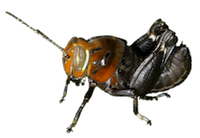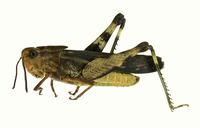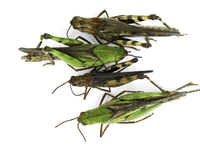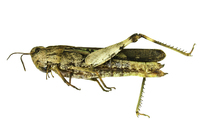Family (Alpha): ACRIDIDAE GRYLLACRIDIDAE GRYLLIDAE GRYLLOTALPIDAE RHAPHIDOPHORIDAE ROMALEIDAE TETRIGIDAE TETTIGONIIDAE TRIDACTYLIDAE
View Acrididae Members:
Metaleptea brevicornis Schistocerca alutacea Schistocerca americana Schistocerca damnifica Schistocerca lineata Schistocerca obscura Schistocerca rubiginosa Schistocerca unidentified species Amblytropidia mysteca Syrbula admirabilis Chloealtis conspersa Eritettix simplex Pseudochorthippus curtipennis Mermiria unidentified species Mermiria bivittata Mermiria intertexta Mermiria picta Dichromorpha elegans Dichromorpha viridis Orphulella pelidna Orphulella speciosa Leptysma marginicollis Stenacris vitreipennis Campylacantha olivacea Paratylotropidia beutenmuelleri Eotettix pusillus Hesperotettix viridis Hesperotettix viridis brevipennis Melanoplus unidentified species Melanoplus viridipes group unidentified species Melanoplus acrophilus Melanoplus angustipennis Melanoplus attenuatus Melanoplus bispinosus Melanoplus bivittatus Melanoplus carnegiei Melanoplus celatus Melanoplus cherokee Melanoplus confusus Melanoplus coreyi Melanoplus deceptus Melanoplus decoratus Melanoplus decorus Melanoplus devius Melanoplus differentialis Melanoplus divergens Melanoplus eurycercus Melanoplus femurrubrum Melanoplus hubbelli Melanoplus impudicus Melanoplus keeleri Melanoplus keeleri keeleri Melanoplus keeleri luridus Melanoplus mirus Melanoplus n. sp. 35 Melanoplus n. sp. 6 Melanoplus nigrescens Melanoplus nossi Melanoplus nubilus Melanoplus pachycercus Melanoplus propinquus Melanoplus punctulatus Melanoplus punctulatus arboreus Melanoplus punctulatus punctulatus Melanoplus sanguinipes Melanoplus sanguinipes atlanis Melanoplus sanguinipes defectus Melanoplus scudderi Melanoplus serrulatus Melanoplus similis Melanoplus strumosus Melanoplus sylvestris Melanoplus tribulus Melanoplus walshii Paroxya atlantica Paroxya clavuligera Booneacris variegata Dendrotettix australis Dendrotettix zimmermanni Stethophyma celatum Arphia unidentified species Arphia granulata Arphia sulphurea Arphia xanthoptera Chortophaga australior Chortophaga viridifasciata Chortophaga unidentified species Encoptolophus sordidus Hippiscus ocelote Pardalophora apiculata Pardalophora phoenicoptera Psinidia fenestralis Trachyrhachys kiowa Dissosteira carolina Spharagemon bolli Spharagemon cristatum Spharagemon marmoratum pictum Trimerotropis maritima Trimerotropis saxatilis NC Records
Chortophaga australior Rehn & Hebard, 1911 - Southern Green-Striped Locust
Taxonomy
Family: Acrididae
Subfamily: OedopodinaeTribe: ChortophaginiSynonym: Chortophaga viridifasciata australior Comments: One of three species in this North American genus that occur north of Mexico (Cigliano et al., 2018), two of which have been recorded in North CarolinaSpecies Status: Described as a full species by Rehn and Hebard (1911) based on morphological and coloration differences from viridifasciata. This distinction was challenged by Blatchley (1920), who noted that the characters used to separate the two are not fixed and are subject to individual variation; he regarded australior "at the most, only a southern geographic race or variety of viridifasciata." This debate continues, with Brust et al. presenting evidence that populations in the western part of its range are only questionably distinct from viridifasciata, but with Otte (1984), Capinera et al. (2004), and Cigliano et al. (2018) continuing to treat it as a distinct species. Since we have at least some populations where the traits characteristic of australior dominate, we will attempt to separate our records for these two forms in order to determine their degree of geographic and/or ecological differentiation in North Carolina.
Identification
Field Guide Descriptions: Capinera et al. (2004) Online Photographs: BugGuide , Google Images ,
iNaturalist , GBIF Technical Description, Adults/Nymphs: Rehn and Hebard (1911); Blatchley (1920); Otte (1984) Comments: A medium-small, brown or green Band-winged Locust. Both sexes come in green or brown phases. The green phase is apple-green on its head, body, and legs; the brown phase is mottled with yellowish brown on its body, with a pale x-shaped mark on the pronotum. The tegmina are mainly dark brown in both phases but have patches of green on the lateral face; a dark blotch is usually present just above the base of the wings. The hind femora are also marked with darker spots (sometimes faint in the green phase) on the upper face. The hind tibiae are brown at the base, followed by a yellow ring, but are glaucous (greenish or bluish) distally. The coloration of viridifasciata is similar, but the tegmina and hind femora are less strongly spotted, if at all. The thorax in the brown phase lacks the yellowish x-mark and the hind tibiae are dull yellowish.Total Length [body plus wings; excludes ovipositor]: 18 mm, males; 24.5 mm, females (Rehn and Hebard, 1911)Forewing Length: 18 mm, males; 21.5 mm, females (Rehn and Hebard, 1911)Structural Features: The rear edge of the pronotum is roughly right-angular in australior but more distinctly acute in viridifasciata. Additionally, Rehn and Hebard (1911) reported that the mid-dorsal ridge of the pronotum is less strongly keeled in australior and the fastigium is broader. No differences in genitalia have been noted, either with respect to the external or internal structures.Structural photos
Singing Behavior: Males crepitate (Blatchley, 1920)
Distribution in North Carolina
County Map: Clicking on a county returns the records for the species in that county.
Adult Dates: Click on graph to enlarge
Habitats and Life History
Habitats: Diet: Observation Methods: Abundance/Frequency: We have too few records to accurately estimate either its frequency of occurrence or abundance. The population at one site in Carteret County appeared to be locally commonAdult Phenology:
Status in North Carolina
Natural Heritage Program Status: Natural Heritage Program Ranks: G5 [S3S4]State Protection: Comments:
Image Gallery for Chortophaga australior - Southern Green-Striped Locust Recorded by: Mark Basinger, Steve Hall, and Gary Perlmutter Recorded by: Mark Basinger, Steve Hall, and Gary Perlmutter Recorded by: Mark Basinger, Jim Petranka, and Becky Elkin Recorded by: Mark Basinger Recorded by: Mark Basinger Recorded by: Mark Basinger Recorded by: Mark Basinger Recorded by: Mark Basinger Recorded by: Mark Basinger Recorded by: J.B. Sullivan Recorded by: J.B. Sullivan Recorded by: J.B. Sullivan Recorded by: J.B. Sullivan Recorded by: J.B. Sullivan Recorded by: J.B. Sullivan

 »
»



 »
»

